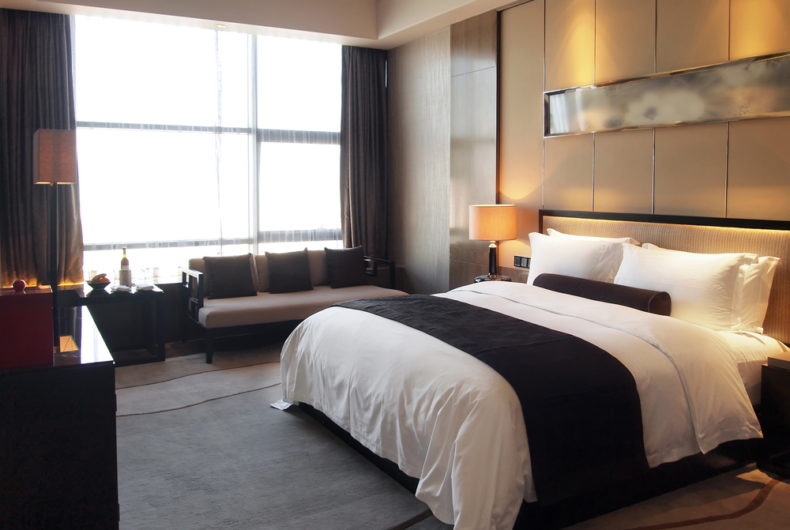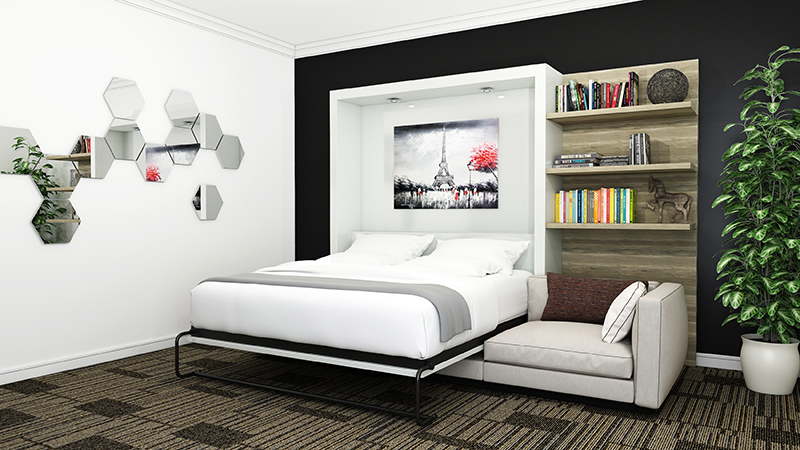
Top Design Trends for Hotels in 2018
Hotels are now a destination in and of themselves, and the hospitality industry’s stand-out hotels stay ahead of the curve by setting the trends. Here is a look at some of the exciting and innovative changes making a splash in the hospitality industry in 2018.
1. Smart Rooms
Technology is changing the guest experience. From mobile bookings and smart check-ins to mobile payments and in-room technology, hotels with more connectivity will appeal to more guests. Gone are the days when there are online and offline guests. Charging stations are now expected in every room, and the more the better.
Smart rooms are the rooms of the future. “All of the major hotel companies are testing this out in various stages,” says Dianna Ting, hospitality editor at Skift. With apps such as Hilton Honors, guests can unlock their rooms with mobile keys and even text requests to hotel staff, rather than placing a call down to the concierge. Still, at other hotels, rooms with personal tablets will allow guests to customize and save their own in-room preferences such as temperature, lighting and entertainment.
Entertainment technology abounds for on-trend hotels as well. Screencasting allows guests to interact with smart TVs to broadcast their own content from YouTube, Netflix, Pandora and other apps. Voice activation is also in place in future trending hotels. Wynn Hotels in Las Vegas were the first to equip rooms with Amazon Echo, and other chains are following suit. Business travelers may enjoy using Alexa for Business to initiate things like video conference calls.
Hotel apps allow guests to save their preferences upon return with things like temperature, lighting, even newspaper delivery and types of toiletries, according to Hotel News New.
Though it may sound futuristic, Marriott has launched in-room virtual reality, and the Cosmopolitan in Vegas has its own AI concierge named Rose, with a spicy personality to boot. While we expect these trends are a little further out than 2018, all signs point to the fact that guests would like the same or better wifi connectivity that they experience at home while they travel.

5 Ways To Save Space In Your Hotel
Learn how to increase hotel revenue when you maximize your space with Wall Beds!
Download Your Guide2. Flexible Meeting Spaces
Hotels are stepping up their game when it comes to meeting spaces, which, more than anything else, need to be flexible in 2018. Walls, equipment, dividers, even furniture are more flexible and portable. Forward-thinking hotels with meeting space should offer flexibility with features like roll-up doors and electrical outlets embedded in the floor. This allows for a fluid use of space for various types of gatherings: corporate meetings, family reunions, wedding receptions, even the ability to turn those spaces back into overflow accommodations with flexible furniture like Wall Beds. (Increased RevPAR, anyone?)
“Multipurpose is the key driver when thinking of the future of event spaces,” according to Steve van der Molen, VP of meeting operations for the Atlantic City region at Caesars Entertainment Corporation. “We are ready for face-to-face meetings where all options are on the table from networking to tradeshows, general sessions and breakouts, and all supported by the newest technologies. The venue has to lend itself to be open for this.”
3. Sustainable Operations
Increasingly, hotel management companies and consumers are placing more demand on sustainable design and operation. Environmentally friendly building materials and sustainable furniture are the next step in the sustainability movement for properties looking to maintain the cutting edge and stand out from the pack.
Start with a small step and see what a difference your property can make. Hospitality industry leaders in sustainability boast Green Seal™ certification, and results show that those who make the investment in sustainable practices stand to profit. Green Seal’s mission is to transform the economy for a healthier, greener world, and a Green Seal certification demonstrates your achievement of leadership standards that help sustain the natural world and protect human life.
To increase your hotel’s green efforts and decrease your footprint, a first easy step is to place cards in guest rooms asking them to reuse towels. The website Scientific American reports that a “150-room hotel can conserve 72,000 gallons of water and 480 gallons of laundry soap every year by placing the cards in its guest rooms.” Hotels can print their own or order them from Green Hotels Association, a non-profit group committed to encouraging, promoting and supporting ecological consciousness in the hospitality industry.
Green Hotels Association, among other things, gives several green ideas for hotels to implement, such as:
- Solar panels for lighting signage and heating water
- Low-flow fixtures
- Toilet tank fill diverters
- Mattress and linen recycling
- Energy-Star appliances
- Programmable thermostats
Another resource for greening your hotel is the World Travel & Tourism Council and their sustainable growth initiative. In particular, they have identified several green issues of special importance in the travel and tourism industry. One of those is climate change and the industry’s impact on it. Hotels can use the Hotel Carbon Measurement Initiative to measure and reduce their carbon footprint.
A third group to look to for green guidance is the International Tourism Partnership’s Green Hoteliers. They provide news, resources, expert commentary and best practice for green hotels throughout the world. They have an extensive collection of case studies on their website showing real-world examples of hotels that have successfully implemented green practices.
One such success story comes from London Heathrow Marriott hotel and highlights several recent innovations that enabled them to reduce their yearly energy consumption by 8% and their carbon emissions by 12%. Some of the steps they took include:
- Hybrid Windmill & Solar Power System on the hotel roof to harness wind and solar power to light the Marriott LED sign.
- Greenhouse on the hotel roof supplying local produce to the hotel restaurants and bars, saving transportation
- LED lighting throughout the hotel includes all exterior and car park lighting reducing energy and carbon emissions.
4. Public Spaces
Hotel trends must meet the needs and desires of their guests, and millennials and their spending power are changing the way hotels design and use their public spaces. Millennials prefer hanging out in public spaces, so they may opt for smaller, more basic rooms at a property with more expansive, exciting public spaces. Lobbies for this generation should be equipped with charging stations, as Hotel Management estimates that the average person today travels with three devices per person.
With the rise of Airbnb and boutique hotels, hotels chains would be wise to give the traditional hotel lobby a more intimate feel that allows guest to feel connected to local culture. Lobbies are no longer simply places to wait around, but one more piece of the guest experience. Today’s hotel managers should be looking for “how many times your guests say Wow!” according to Chad McWhinney, CEO of Denver-based developer/property manager McWhinney.
Tom Ito, AIA, LEED AP, Gensler’s Lifestyle Sector Leader says that “lobbies and lobby bars are becoming more than just a place to wait.” They are a place that takes center stage, a place to be seen. When a guest is wowed, they are likely to take selfies, share them on social media, and influence their friends to stay at the same hotel.
The hotel public spaces of tomorrow should focus on local culture and create opportunities to bring people together to have experiences in the space. The design and function of the traditional hotel lobby is evolving, as concierges with tablets will greet visitors at sofas rather than stand behind front desks. A new design should include public privacy – flexible, multipurpose spaces for folks to hang out and be around other people to converse, eat, work and relax. The space might include local art, a place to gather and enjoy local food trucks, or a private space to work while simply being around other people. The design of the new hotel lobby “encourages guests to get out of their rooms and into this giant living room, which works as a central meeting point and crossroad,” according to OBMI architecture firm, whose properties include Four Seasons, Hilton, Westin and Embassy Suites, just to name a few. This “giant living room” concept encourages guests to want to stay in (and spend) rather than get out of the hotel.
5. Biophilic Design
Biophilia, the affinity of humans for the natural world, is certainly having its design moment in 2018. The term biophilia was coined by German psychologist Eric Fromm and made popular by American biologist Edward O. Wilson in the 1980s. You might recognize its design influence in spaces with an abundance of natural light, internal and external views of nature, use of natural and sustainable materials, and vertical gardens. Besides being beautiful, biophilic design has other benefits too.
Benefits for Guests
- “We know from talking to neuroscientists, psychologists and endocrinologists that biophilic elements can lower a person’s heart rate, blood pressure and cortisol levels,” says Bill Browning, partner at sustainable architecture firm Terrapin Bright Green. “The higher-end hotel brands are starting to pay attention to this connection with nature,” he says.
- “When people have access to natural design within their spaces, their heart rates come down and their cortisol levels come down,” said David Gerson, Interface Hospitality’s VP of marketing.
Benefits for Hotels
- “Guests will spend on average 36% more time in hotel lobbies that have biophilic elements.” Terrapin Bright Green
- “Guests are willing to pay 23% more for rooms with views of biophilic elements.” Oliver Heath Design
- Hotel employees may experience psychological responses, such as “adaptability, alertness, attention, concentration, and emotion and mood.” Terrapin Bright Green
So, what types of biophilic design strategies can hotels implement to keep employees productive and healthy while enhancing the guest experience and keep the spending cash flowing? For the answer, we turn to Terrapin Bright Green, the pioneer of biophilic design. They maintain that there are fourteen biophilic design patterns, which include things like a visual connection with nature, the presence of water, dynamic and diffuse light, among other things.
The key takeaway is that incorporating nature into your design and guest experience leads to healthier and happier guests and employees.
6. Unique Experience
Large-scale chain hotels are taking a page from the boutique hotels by creating more personalized touches, unique to the demographics they wish to connect with. While sameness once meant security, digital communications, online reviews and social media have taken the fear out of staying somewhere new and different. The hospitality industry has taken note. Big brands are acquiring boutique properties. Hotels are moving away from matchy-matchy and creating unique one-of-a-kind properties with more local flair.
Perhaps this is the influence of the millennial traveler; perhaps it stems from the hunger for new experiences. Whatever the reason, brands are not only noticing, but they are getting on board. Hotels looking to cash in on this trend can look to bring the local culture in. From local food and beverages to local sports teams, the guest experience can be built around the local vibe. Building materials, artwork and even color and motif can play around a central local theme.
For a nod to Airbnb, hotel designers might opt for a more intimate, home-like feel in smaller guest rooms, especially as the current trend with millennial travelers involves spending less time in the room and more time in shared public spaces
The evolution of today’s hotel is bringing exciting changes to the 2018 hospitality industry.







